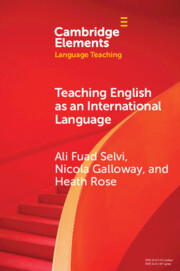Element contents
Teaching English as an International Language
Published online by Cambridge University Press: 20 December 2023
Summary
Keywords
- Type
- Element
- Information
- Series: Elements in Language TeachingOnline ISBN: 9781108902755Publisher: Cambridge University PressPrint publication: 01 February 2024
References
- 4
- Cited by

